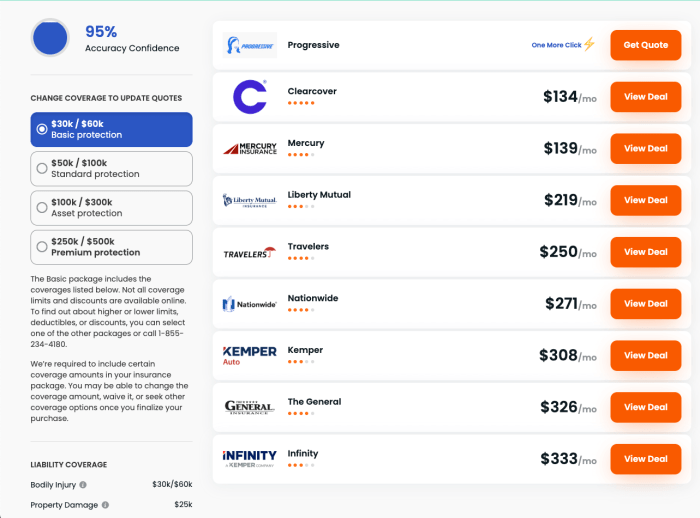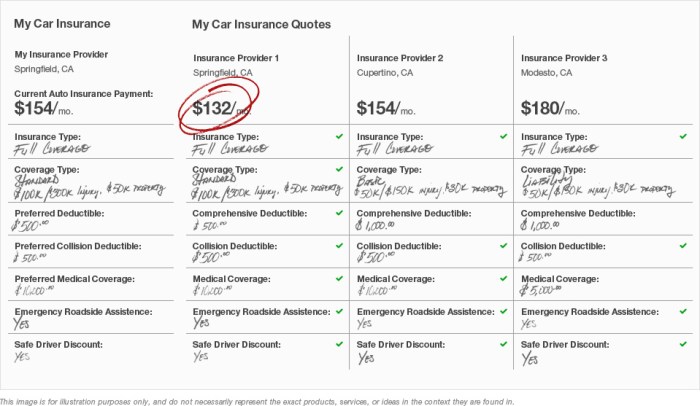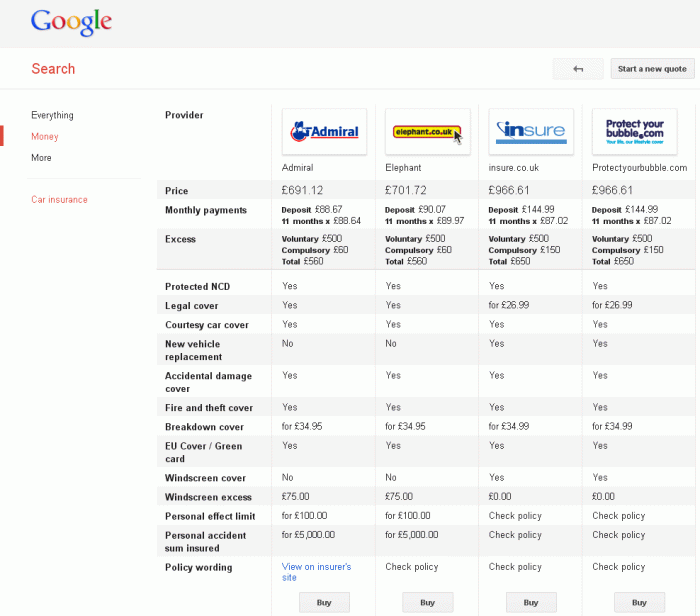
Navigating the world of auto insurance can feel overwhelming. With a plethora of providers, coverage options, and confusing jargon, finding the right policy at the best price requires careful consideration. This guide aims to demystify the process, empowering you to compare auto insurance effectively and make informed decisions that protect your financial well-being and peace of mind.
We will explore various types of auto insurance coverage, examining their benefits and costs. We’ll delve into the factors influencing premiums, allowing you to understand how your driving history, location, and vehicle choice impact your rates. By comparing leading insurance providers, analyzing their services, claims processes, and customer reviews, you’ll gain valuable insights to guide your selection. Finally, we’ll provide practical tips on securing discounts, understanding policy details, and filing claims efficiently.
Types of Auto Insurance

Choosing the right auto insurance coverage can feel overwhelming, but understanding the different types available is key to protecting yourself and your vehicle. This section will break down four common types of coverage: liability, collision, comprehensive, and uninsured/underinsured motorist. We’ll explore what each covers, when you might need it, and provide a general idea of cost variations.
Liability Coverage
Liability insurance covers damages you cause to other people or their property in an accident. This is typically the minimum coverage required by law. It usually includes bodily injury liability and property damage liability. Bodily injury liability pays for medical bills, lost wages, and pain and suffering of others injured in an accident you caused. Property damage liability covers the cost of repairing or replacing the other person’s damaged vehicle or property. For example, if you rear-end another car and cause $5,000 in damages and $10,000 in medical bills for the other driver, your liability coverage would pay for these costs (up to your policy limits).
Collision Coverage
Collision coverage pays for repairs or replacement of your vehicle if it’s damaged in an accident, regardless of who is at fault. This means even if you cause the accident, your collision coverage will help pay for the damage to your own car. For instance, if you hit a tree, your collision coverage will pay for the repairs, minus your deductible. This coverage is optional but highly recommended.
Comprehensive Coverage
Comprehensive coverage protects your vehicle from damage caused by events other than collisions. This includes things like theft, vandalism, fire, hail, flood, and animal damage. Imagine a tree falls on your car during a storm; comprehensive coverage would help cover the repair costs. It’s important to note that this coverage typically doesn’t pay for damage caused by collisions.
Uninsured/Underinsured Motorist Coverage
Uninsured/underinsured motorist (UM/UIM) coverage protects you if you’re involved in an accident with an uninsured or underinsured driver. If the at-fault driver doesn’t have enough insurance to cover your medical bills or vehicle repairs, your UM/UIM coverage steps in to help. For example, if you’re hit by a driver with no insurance and sustain significant injuries, your UM/UIM coverage would assist in paying your medical expenses.
Average Cost Comparison by Age Group
The cost of auto insurance varies greatly depending on several factors, including age, driving record, location, and the type and amount of coverage. The following table provides a *general* estimate of average annual costs. These figures are illustrative and should not be considered exact quotes. Actual costs will vary significantly depending on the factors mentioned above.
| Coverage Type | 16-25 | 26-35 | 36-55 | 56+ |
|---|---|---|---|---|
| Liability | $1200 | $900 | $750 | $600 |
| Collision | $1500 | $1200 | $900 | $750 |
| Comprehensive | $800 | $600 | $500 | $400 |
| UM/UIM | $300 | $250 | $200 | $150 |
Factors Affecting Auto Insurance Premiums
Several interconnected factors influence the cost of your auto insurance premiums. Understanding these factors can help you make informed decisions to potentially lower your costs. Insurance companies assess risk meticulously, and the elements discussed below are key components of that risk assessment.
Your auto insurance premium isn’t simply a random number; it’s a calculated reflection of your individual risk profile. This profile is constructed using a combination of statistical data and individual information you provide during the application process. The higher the perceived risk, the higher your premium will be.
Driving History
Your driving record significantly impacts your premiums. A clean driving history, free from accidents and traffic violations, indicates a lower risk to the insurance company. Conversely, accidents, especially those resulting in significant damage or injuries, will substantially increase your premiums. Similarly, multiple speeding tickets or other moving violations will reflect negatively on your risk profile. Insurance companies often use a points system to track violations, with each point leading to a premium increase. For instance, a DUI conviction will typically result in a much higher premium increase than a single speeding ticket.
Age
Age is another crucial factor. Younger drivers, particularly those under 25, are statistically involved in more accidents than older, more experienced drivers. This higher risk profile translates to higher premiums for young drivers. As drivers age and gain experience, their premiums typically decrease, reflecting a reduced risk of accidents. Insurance companies recognize this trend and adjust premiums accordingly. For example, a 16-year-old driver will generally pay significantly more than a 50-year-old driver with a similar driving record.
Location
Where you live significantly influences your insurance rates. Areas with high crime rates, frequent accidents, or higher rates of vehicle theft will typically have higher insurance premiums. Insurance companies consider the frequency and severity of claims in specific geographic locations when setting rates. Living in a rural area with fewer vehicles and lower accident rates may result in lower premiums compared to living in a densely populated urban center. For example, a driver in a high-crime city might pay considerably more than a driver in a quiet suburban neighborhood.
Vehicle Type
The type of vehicle you drive also plays a role in determining your premium. Sports cars and luxury vehicles are often more expensive to repair and replace, leading to higher insurance premiums. The vehicle’s safety features also factor in; vehicles with advanced safety technologies might receive lower premiums. Conversely, older vehicles, particularly those with a history of mechanical problems, may also lead to higher premiums due to increased risk of breakdowns and accidents. For instance, a new, high-safety-rated SUV will likely have a lower premium than a vintage sports car.
Risk Factors and Premium Impact
The following bullet points illustrate how different risk factors can influence premiums:
- Higher Premiums: Multiple accidents, DUI convictions, young age (under 25), living in a high-risk area, driving a high-performance or expensive vehicle, poor credit history.
- Lower Premiums: Clean driving record, older age (over 50), living in a low-risk area, driving a fuel-efficient or older vehicle with lower repair costs, good credit history, vehicle equipped with advanced safety features.
Discounts and Savings on Auto Insurance

Saving money on your auto insurance is a worthwhile goal, and thankfully, many opportunities exist to reduce your premiums. Insurance companies offer a variety of discounts to incentivize safe driving habits and responsible behavior. Understanding these discounts and how they stack can significantly lower your overall cost.
Common Auto Insurance Discounts
Several common discounts can substantially reduce your auto insurance premiums. These discounts often depend on your individual circumstances and driving history. Careful consideration of eligibility criteria is essential to maximizing your savings.
- Safe Driver Discount: This is perhaps the most common discount, rewarding drivers with clean driving records. Insurance companies typically track accidents and traffic violations. A driver with no accidents or moving violations within a specific timeframe (usually three to five years) is highly likely to qualify for this discount, which can range from 5% to 25% or more, depending on the insurer and the driver’s history.
- Bundling Discount: Many insurance companies offer discounts for bundling multiple insurance policies, such as home and auto insurance, under a single provider. This simplifies billing and demonstrates customer loyalty, leading to significant savings—often 10% to 25% or more, depending on the policies bundled.
- Good Student Discount: Students who maintain a certain grade point average (GPA) typically qualify for this discount. The required GPA varies by insurer, but it usually falls within the range of 3.0 to 3.5. This discount reflects the reduced risk associated with responsible, academically successful students, offering savings of 10% to 25% or more.
- Anti-theft Device Discount: Installing anti-theft devices in your vehicle, such as alarms or tracking systems, can demonstrate your commitment to vehicle security. This often results in a discount, usually around 5% to 15%, reflecting the reduced risk of theft.
- Vehicle Safety Feature Discount: Cars equipped with advanced safety features like anti-lock brakes (ABS), airbags, and electronic stability control (ESC) are statistically involved in fewer accidents. Insurers often reward this by offering discounts, typically ranging from 5% to 15%.
Calculating Potential Savings
Let’s illustrate how these discounts can combine to create substantial savings. Assume a base annual premium of $1200.
| Discount | Percentage | Savings | New Premium |
|---|---|---|---|
| Safe Driver | 15% | $180 | $1020 |
| Bundling | 10% | $102 | $918 |
| Good Student | 10% | $91.80 | $826.20 |
In this example, combining the safe driver, bundling, and good student discounts results in a total savings of $373.80, reducing the annual premium from $1200 to $826.20. This represents a 31.15% reduction. Note that discount percentages and availability vary by insurance company and policy.
Choosing the Right Coverage
Selecting the right auto insurance coverage is crucial for protecting yourself financially in the event of an accident. The appropriate level of coverage depends on several factors, and understanding these factors will help you make an informed decision that balances protection with affordability. Choosing inadequate coverage can leave you vulnerable to significant financial losses, while over-insuring can lead to unnecessary expenses.
Determining the appropriate level of coverage involves a careful assessment of your individual risk profile and financial circumstances. This includes considering the value of your vehicle, your driving history, the amount of liability you might incur, and your personal financial resources. By carefully weighing these factors, you can choose a policy that offers the optimal balance of protection and cost-effectiveness.
Liability Coverage Levels
Liability coverage protects you financially if you cause an accident that injures someone or damages their property. States mandate minimum liability coverage amounts, but these minimums may not be sufficient to cover significant damages. Higher liability limits offer greater protection against substantial financial losses. For example, a policy with $100,000/$300,000 liability coverage means $100,000 per person injured and $300,000 per accident for bodily injury. Consider your personal assets and potential exposure to liability when choosing liability limits. A higher limit provides a safety net against catastrophic financial consequences.
Collision and Comprehensive Coverage
Collision coverage pays for damage to your vehicle caused by an accident, regardless of fault. Comprehensive coverage protects against damage caused by events other than collisions, such as theft, vandalism, or hail. The decision of whether to carry these coverages often depends on the age and value of your vehicle. For newer, more expensive cars, these coverages are generally advisable to protect your investment. For older vehicles, the cost of these coverages may outweigh the potential benefit, especially if the vehicle’s value is low. Consider the cost of repairs or replacement versus the premium cost when making this decision.
Uninsured/Underinsured Motorist Coverage
This coverage protects you if you’re involved in an accident with an uninsured or underinsured driver. It’s essential because many drivers operate without adequate insurance. Uninsured/underinsured motorist coverage can help cover your medical bills and vehicle repairs even if the at-fault driver is uninsured or doesn’t have sufficient coverage to compensate you for your losses. Choosing a high limit for this coverage is prudent, especially in areas with high rates of uninsured drivers. The peace of mind it offers is often worth the additional cost.
Choosing the Right Deductible
The deductible is the amount you pay out-of-pocket before your insurance coverage kicks in. Higher deductibles generally result in lower premiums. Choosing the right deductible involves balancing the cost savings with your ability to absorb a potential out-of-pocket expense. Consider your financial situation and risk tolerance when determining the appropriate deductible amount. A higher deductible may be suitable if you have emergency savings to cover a larger out-of-pocket expense.
Auto Insurance Coverage Checklist
Before purchasing auto insurance, consider reviewing the following:
- Assess your vehicle’s value: Determine the current market value of your vehicle to help decide on appropriate coverage levels.
- Review your driving history: A clean driving record may qualify you for discounts and lower premiums.
- Consider your financial situation: Evaluate your ability to pay deductibles and potential out-of-pocket expenses.
- Compare quotes from multiple insurers: Obtain quotes from several companies to find the best rates for your needs.
- Understand your state’s minimum insurance requirements: Ensure you meet the minimum liability coverage mandated by your state.
- Evaluate your risk tolerance: Consider your comfort level with different deductible amounts and coverage limits.
- Read your policy carefully: Understand the terms, conditions, and exclusions of your chosen policy before signing.
Ending Remarks

Choosing the right auto insurance policy is a crucial financial decision. By carefully comparing providers, understanding coverage options, and actively seeking discounts, you can secure comprehensive protection without overspending. Remember to regularly review your policy and adapt your coverage as your needs evolve. Armed with the knowledge presented in this guide, you are well-equipped to navigate the complexities of auto insurance and find the perfect fit for your individual circumstances. Driving safely and responsibly will further contribute to lower premiums and a secure future.
FAQ Overview
What is the difference between liability and collision coverage?
Liability coverage pays for damages you cause to others, while collision coverage pays for damage to your own vehicle, regardless of fault.
How often should I review my auto insurance policy?
It’s advisable to review your policy annually or whenever significant life changes occur (new car, change in address, etc.).
Can I get auto insurance if I have a poor driving record?
Yes, but you’ll likely pay higher premiums. Some insurers specialize in high-risk drivers.
What documents do I need to file an auto insurance claim?
Typically, you’ll need police reports, photos of the damage, and contact information for all parties involved.